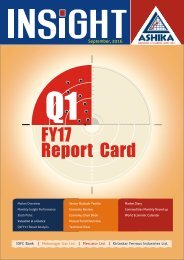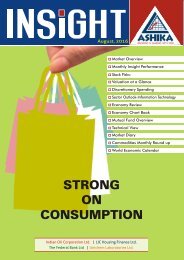You also want an ePaper? Increase the reach of your titles
YUMPU automatically turns print PDFs into web optimized ePapers that Google loves.
AUGUST <strong>2016</strong><br />
DESCRETIONARY SPENDING<br />
product (GDP) growth by up to 70 basis points over two<br />
quarters. According to the report, the direct impact of an<br />
increase in rural growth is between 45 and 50 bps, the<br />
higher impact would have positive spillover effects<br />
through the urban economy. There are eight indicators to<br />
sense the rural growth which includes two-wheeler &<br />
passenger car sales, household kerosene consumption,<br />
tractor sales, agriculture loans, power demand, yarn<br />
production, agriculture exports and government<br />
expenditure on rural areas. Further, the report also stated<br />
that there is an expectation, consumption to grow steadily<br />
once the proceeds of the Pay Commission and the effects<br />
of good monsoon play out. Higher rural growth could also<br />
cool down headline inflation by 40 bps, due to easing of<br />
supply constraints. Though in the interim period inflation<br />
may edge upwards owing to demand pressures. A good<br />
well spread monsoon across the country would bolster<br />
farm income and boost rural discretionary spending.<br />
Consecutive droughts in a row have also meant that rural<br />
demand has declined significantly, leaving urban demand<br />
and public investment to drive the economy in the<br />
absence of pick-up in private investment. A normal to<br />
above normal monsoon is positive news for rural demand<br />
and for food prices. A bumper crop production would<br />
help to keep the prices of pulses and vegetables under<br />
check which in turn reduce headline inflation and would<br />
encourage RBI to lower down interest rate further, thus<br />
helping to revive the demand in economy. Even,<br />
government is very proactive in boosting rural<br />
consumption thus have increased the budgeted allocation<br />
towards rural areas during FY17 budget. The Union<br />
Budget for FY17 reflected the government’s firm<br />
commitment to substantially boost investment in<br />
Agriculture, Social Sector, Infrastructure and Employment<br />
generation. The government has envisaged of doubling<br />
the farmer’s income in the next five years. To achieve<br />
that, government has increased budgetary allocation to<br />
the ministry of Agriculture and Farmers welfare by ~94%<br />
YoY to ~Rs 445 billion and ~25% YoY increase in total<br />
Plan rural spending at Rs 878 billion during FY17. Such<br />
massive budgetary allocation towards rural development<br />
would augment farms productivity and rural income which<br />
in turn promote more discretionary spending.<br />
Rs. in billion<br />
FY08<br />
FY09<br />
FY10<br />
FY11<br />
FY12<br />
FY13<br />
FY14<br />
FY15<br />
FY16BE<br />
FY17E<br />
Source: Union Budget document<br />
Source: Economic Survey FY 16<br />
GST to discover more rational pricing for consumer<br />
products<br />
GST (Goods & service tax) is the single most powerful tax<br />
reforms that India is going to see. The objective of GST is<br />
to end the regime of multiple taxes on goods and services<br />
and bring them under one rate, which would make the<br />
pricing of the products more rational. The system will<br />
change from the current production-based taxation to<br />
being consumption-based, which would bring uniformity in<br />
taxes across states and is expected to increase efficiency<br />
and compliance in the system. GST will replace all the<br />
indirect taxes including central excise duty, value added<br />
tax, service tax, octroi, luxury tax with a single tax rate. For<br />
manufactured consumer goods, the current tax regime<br />
mean the consumer pays ~ 25-26% more than the cost of<br />
production due to excise duty and value added tax.<br />
24






